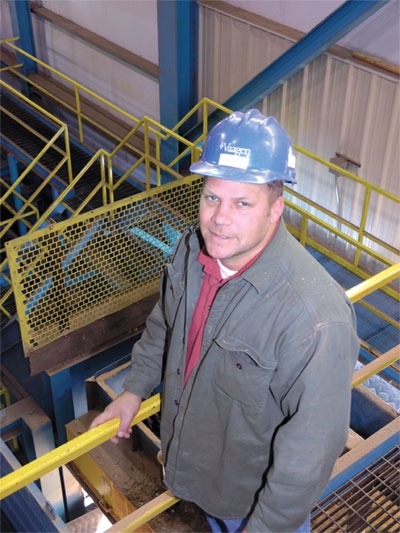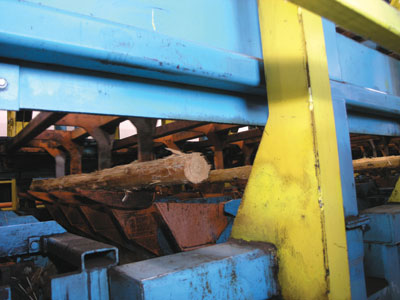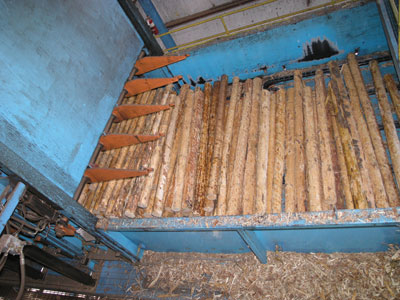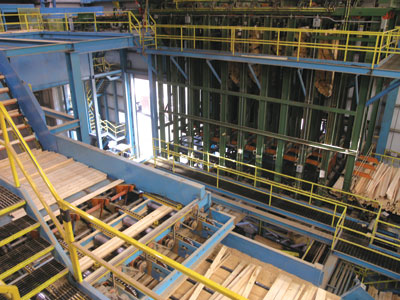
Features
Mills
Sawmilling
Vaagen’s Newest Stud
After the big earthquake, you can be sure of two things. Wooden structures will have fared best, and the stud line at Vaagen Bros. Lumber’s sawmill in Usk, WA will still be standing. The company acquired the mill in October 2006 from Steve Hermann, and it’s fair to say that the local sawmill innovator may have liked lumber, but he loved steel.
December 1, 2011 By Scott Jamieson
 Mill manager Daryl Evans in the mill backend. After the big earthquake
Mill manager Daryl Evans in the mill backend. After the big earthquakeStill, it wasn’t the ubiquitous steel supports that attracted the father and son team of Duane and Russ Vaagen to this modern stud mill. Instead it was the wood. The company’s headquarters and original sawmill lies just an hour to the west in Colville, WA, and so picking up the Usk mill was as much about defence as it was expansion.
“We’ve got a good small log supply network set up here,” Russ explains at the Colville head office. “We’ve built it up over the years as we established ourselves as the small-log buyer in the region, and we’ve been working hard ever since the spotted owl controversy to increase the harvest from the Colville National Forest. After a lot of work with a local coalition of stakeholders and environmental groups it’s gone from a low of just over 20 million bdft a few years ago to now over 40 million bdft, and we think it can support 80 million bdft. But log supply is always a concern here. With the Usk mill just in the next valley, acquiring it sets up a nice buffer for our log supply here,” the third generation sawmiller says of a long-term strategy that few Canadian sawmillers outside of eastern Canada can truly grasp.
Yet Vaagen Bros. got more than a well-anchored sawmill and fibre buffer in the $USD 20 million deal. It also bagged a highly-efficient stud mill almost custom-built to match its corporate identity of converting the region’s small-log and marginal timber supply into an array of saleable products, from chips and hog fuel to square lumber and timbers (see our cover feature on the Vaagen’s flagship mill in Colville in CWP Nov/Dec, or on line at www.canadianwoodproducts.ca).
“It’s a great asset for its ability to take lower grade wood and mixed pulp wood and recover valuable products,” Russ explains as we wander through an extensive portable chip plant that covers one entire side of the mill. Its collection of Nicholson debarkers and chippers, and Rawlings hogs lets the mill handle just about any of its own low-grade material and a fair bit of custom work without affecting the main mill flow at all. Yet even inside the mill is an array of design features to extract defects and pulp wood without sacrificing line speed.
Unique Producer
The mill accepts a mix of 65% tree length and 35% CTL logs, all stored in a massive, orderly log yard. CTL logs go through a Nicholson debarker and then right to the sorter, while tree length starts a complex journey first by going through an initial culling process. A slasher operator eye balls the incoming logs, sorting out the obvious pulp wood or defects up front. Logs continue on to Nicholson debarkers and then to bi-directional kickers that either kick logs to the chipper or to a transverse slasher deck that looks a lot like the front end of some of the more efficient Quebec stud mills. It’s at this point that a visitor starts to get a feel for the original owner’s love of steel – One of the kickers looks more like car crusher than log kicker, especially given the size of logs the mill processes.
After slashing comes yet another chance to drop out pulp wood – a photocell verifies log diameter here, allowing pulp material to travel straight ahead to a pulp sort. What passes for sawlog material in these markets (minimum of 4.25 in top diameter) is sent to the mill’s most unique touch – an absolutely massive bin sorter built for logs instead of lumber. Like much of the mill’s log and lumber handling systems, this monster log sorter was designed in conjunction with sawmill consultant Bryant Hollins out of 100 Mile House, BC. It re-defines the word “heavy-duty” even for an industry known for over-building.

Still, it is also remarkably smooth and quiet, and not nearly as maintenance-intensive as visitors would think, Russ adds as he sees me gawking at the solid steel supports and gigantic motors. Logs are scanned ahead of the sorter via transverse XY scanners, and sorted into one of 20 bins by solution for batch feeding to the sawline. Like over-sized boards in a sawmill, logs glide along the top of the sorter to be dropped into bins by the world’s most skookum J-bars. Bins hold anywhere from 30 logs in the largest sort to hundreds in the smallest pattern, the latter yielding a single 2 x 4 pattern.

Sorts are dropped down one at a time for ribbon feeding the mill’s sole producer – a HewSaw R200 Plus – via a Linden step feeder with gap control. Like any true small-log producer, the mill is obsessed with eliminating any unnecessary dead space. A separate step feeder is set to feed a mixed scan-n-set sort from the other side of the infeed in the event of any delays or jam ups in the main supply.
The mill uses a conventional HewSaw banana-style infeed rather than the supplier’s more sophisticated log positioner for optimized rotation and positioning. After the highly successful ROI seen by adding a Comact optimized log rotator to its HewSaw R200 at the Colville mill, Russ says they are looking at a similar project here.
“Our big challenge is space – The line wasn’t designed to fit a standard optimized log rotator. But the potential is worth taking a second look, so we’re talking to Stéphane Morin (ProLogic+) about finding a solution. He’s got some ideas, and it’s something we’ve got to do.”
While the R200 at Colville hums along at up to 570 fpm, the HewSaw R200 Plus here literally sings at up to 700 fpm depending on sort. And even more than the Colville mill, the Usk stud line is geared to square edge lumber. In fact it has a heavy focus these days on actual squares, from 4x4s to 6x6s and 7x9s, along with a few special cuts.
“It makes a really nice product,” Russ says as we look over some bundles of rough green squares in the yard. “There’s no wane in it, and we can even make it from some pretty low grade logs,” he adds in describing a business formula that sounds better than making more unwanted 2x4s from high grade logs.

The HewSaw dumps lumber onto a green chain, although a bridge conveyor can drop into place allowing squares to go directly to the sorter. Lumber travels through a Coe Newnes trimmer with Softac optimization, and then over a three-way flip gate that can divert defects or reman pieces to a TMT high-speed board edger, also with Softac optimization. Just as the front end is built to handle a diverse, mixed-quality log supply without sacrificing lineal flow, the back end is also a study in production flexibility. It features a wide array of diverters and redundant conveyors to allow the flow to by-pass any blockages.
Lumber is solid green piled and sent to the main Colville plant or another local planer mill for stickering, drying, and dressing. The mill can make between 8.5 and 9 million bdft per month, along with over 30 loads of chips per day.
“With the current markets, we are looking at ways to handle more drying and planing in-house at Colville,” Russ says. “But other than that, this has been a really good addition to the company. It fits into what we’ve been trying to do as a company for almost the past 20 years.”
Editor’s Note: At press time, Vaagen Bros. Lumber announced curtailments at both its mills in response to markets that go beyond rough, according to Russ Vaagen. The company had taken a raft of innovative steps to keep working, but Russ admits that “Nobody is immune to this thing.” The sawmill in Colville shut down from Feb 16 to March 2, with another shutdown planned for April. Starting in February the Usk mill is to run primarily as a whole log chip plant until markets improve, with most of the workforce staying on part time. More curtailment news at www.canadianwoodproducts.ca.
Print this page